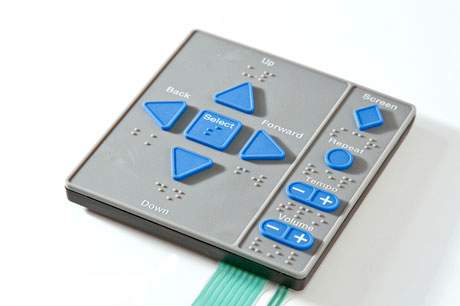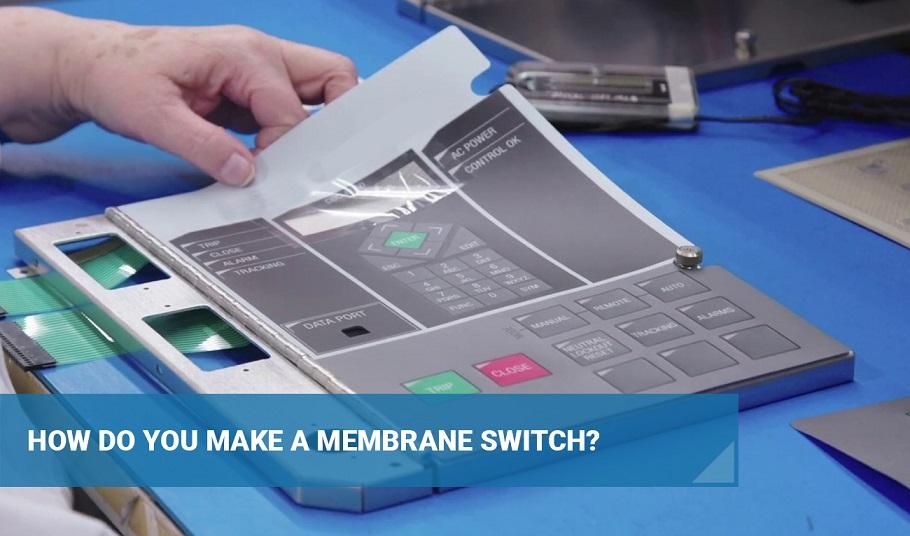Proven Membrane Switch Manufacturer for High-Quality Control Panels
Proven Membrane Switch Manufacturer for High-Quality Control Panels
Blog Article
Comprehending the Relevance of Membrane Switch in Modern Electronics and Their Applications
Membrane switches work as an important part in modern electronic devices, offering an effective user interface for user communication. Their personalized and lightweight nature makes them appropriate for a variety of applications across diverse markets. Recognizing their essential elements and benefits can offer insights right into their expanding relevance. As innovation proceeds to advance, the development of Membrane changes questions about their future applications and style technologies. What lies ahead in this dynamic field?

What Are Membrane Switches?
Membrane switches are important parts in contemporary electronics, acting as interface that facilitate communication between customers and devices. These buttons contain several layers, consisting of a graphic overlay, a sticky layer, and a circuit layer, all of which job together to produce a durable and useful user interface. The design permits a flat, inconspicuous solution that can be personalized regarding dimension, form, and visual look, making them suitable for different applications, from customer electronics to clinical devices. The responsive responses offered by Membrane switches over enhances user experience, while their resistance to dust and moisture makes them ideal for challenging environments. Moreover, Membrane switches can incorporate features such as backlighting and published graphics, even more expanding their use. Their versatility and robustness make them a recommended option in industries where dependability and ease of use are vital, inevitably adding to the smooth procedure of modern-day digital gadgets.
Key Components of Membrane Changes
While different elements contribute to the capability of a membrane button, 3 key layers play significant roles in its design and operation. The leading layer, generally made from a durable polymer, works as the interface for customer interaction, commonly including published icons and graphics. Below this is the spacer layer, which maintains the necessary distance between the top layer and the circuit layer. This spacer layer assurances that the switch turns on just when pressed, protecting against unexpected inputs. Finally, the circuit layer consists of conductive traces that finish the electric circuit when the top layer is depressed. These traces can be made from numerous products, consisting of copper or silver. Together, these parts develop a durable and trustworthy device that is portable and flexible, ideal for a vast array of digital applications, from household appliances to medical gadgets. Comprehending these key components is important for appreciating the general performance of Membrane switches.
Benefits of Making Use Of Membrane Changes

Membrane Switch Production Refine
Understanding the Membrane switch production procedure exposes the intricate actions entailed in producing these necessary elements. The process usually begins with the layout phase, where formats and specs are produced using specialized software. Following this, the visuals overlay is published on an adaptable substrate, commonly using high-resolution printing methods to guarantee quality and precision.Next, the adhesive layers are used, which offer to bond the different parts together. The circuit layers, made from conductive inks or materials, are then printed onto a different substratum. These layers are very carefully aligned and laminated to create a practical switch.After assembly, the switches go through evaluating to confirm capability and longevity. Quality control steps are implemented throughout the procedure to recognize and fix any type of issues. Lastly, the completed Membrane buttons are packaged and planned for distribution, ready to satisfy the needs of contemporary digital applications.
Applications of Membrane Changes in Numerous Industries
Membrane buttons are increasingly used across numerous markets, particularly in medical devices and customer electronic devices. In the medical area, they provide trustworthy control interfaces for tools that require accurate operation. In consumer electronics, these switches enhance user interaction by providing sleek and responsive interfaces. Receptive Medical Devices Control
Various modern clinical tools make use of Membrane switches for streamlined procedure and improved individual interaction. These buttons provide a dependable, long lasting interface for a variety of applications, consisting of diagnostic devices, patient tracking systems, and medical instruments. Their personalized styles allow for specific formats that can fit the distinct demands of healthcare professionals, making sure intuitive navigation and efficient access to essential functions. Related Site In addition, Membrane buttons are immune to pollutants, making them ideal for sterilized environments. The tactile comments they provide can enhance individual confidence, minimizing the danger of mistakes throughout essential medical treatments. In general, the combination of Membrane buttons in medical devices greatly adds to boosted operational performance and individual safety and security in medical care settings.
Consumer Electronics Interfaces
In the domain name of Visit Your URL consumer electronic devices, Membrane switches play a crucial duty in enhancing user interfaces across a broad array of tools. These buttons are essential to items such as push-button controls, microwaves, and gaming consoles, offering a straightforward and effective user interface. Their style enables a smooth combination of graphics and functionality, enabling makers to produce smooth, modern-day looks without jeopardizing usability. Membrane switches are likewise known for their sturdiness, usually withstanding considerable use and exposure to numerous environmental conditions. Furthermore, they can include functions like backlighting and tactile feedback, additional enhancing the customer experience. As customer demands for sophisticated yet intuitive user interfaces expand, Membrane switches proceed to be an important component beforehand electronic gadget performance.
Design Factors To Consider for Membrane Switches
Creating effective Membrane changes needs careful interest to various factors that affect both capability and individual experience. One crucial factor to consider is the option of materials, as they can affect resilience, tactile responses, and visual allure. Selecting an ideal adhesive is important for assuring long-lasting bond and resistance to ecological factors.In enhancement, the layout and layout of the button must suit customer interaction, with switch sizes and spacing enhanced for ease of use. The unification of graphics and labeling ought to focus on quality and presence under various illumination conditions.Consideration of electrical characteristics, such as actuation force and switch sensitivity, will certainly boost the responsiveness of the Membrane button. The design ought navigate to this site to fit making processes to ensure cost-effectiveness and timely production. In general, a well-thought-out layout boosts both the functionality and the individual experience of Membrane switches in contemporary electronic devices.

Future Trends in Membrane Switch Innovation
As innovation remains to advance, Membrane buttons are poised to incorporate brand-new advancements that will certainly enhance their functionality and application in numerous areas. One substantial pattern is the unification of flexible and resilient materials, which will certainly increase the life-span and dependability of these switches. Improved surface area textures and personalized graphics are also anticipated, permitting more intuitive user interfaces.Moreover, the combination of clever modern technology, such as touch-sensitive surface areas and haptic responses, is expected to enhance individual interaction, making Membrane changes extra receptive and appealing. In addition, advances in published electronics will certainly enable more complicated circuitry within thinner profiles, better expanding layout possibilities.Sustainability will also play an important function in future developments, as makers discover environmentally friendly products and production processes. Overall, these patterns will ensure that Membrane changes stay essential and appropriate in a increasingly digital and interconnected world.
Regularly Asked Questions
Exactly How Do Membrane Switches Over Compare to Standard Mechanical Buttons?
Membrane switches offer advantages over traditional mechanical switches, consisting of decreased size, lighter weight, and improved durability. They generally offer a secured surface, boosting resistance to dust and dampness, making them suitable for varied applications.
What Materials Are Typically Utilized in Membrane Switch Building And Construction?

Can Membrane Changes Withstand Extreme Environmental Issues?
Membrane switches can withstand severe ecological problems, depending upon their design and products. Top quality constructions frequently feature durability versus temperature level fluctuations, moisture, and direct exposure to chemicals, making them suitable for numerous requiring applications throughout industries.
For How Long Do Membrane Switches Normally Last Prior To Failure?
Membrane changes commonly exhibit a life expectancy varying from 1 to 10 million actuations, depending on elements such as use regularity, ecological problems, and making quality. Regular maintenance can prolong their longevity and functional reliability significantly.
Are Membrane Changes Personalized for Specific Applications?
Membrane buttons are indeed customizable for particular applications. They can be tailored in style, dimension, and capability, permitting suppliers to fulfill one-of-a-kind customer needs and boost item aesthetics while keeping functional performance and resilience. Membrane buttons are crucial parts in contemporary electronics, serving as customer interfaces that promote communication between users and gadgets. The responsive comments supplied by Membrane switches boosts individual experience, while their resistance to dust and moisture makes them ideal for testing atmospheres. The incorporation of graphics and labeling should focus on clearness and visibility under numerous illumination conditions.Consideration of electrical features, such as actuation pressure and switch level of sensitivity, will certainly enhance the responsiveness of the Membrane switch. Enhanced surface area appearances and customizable graphics are additionally expected, permitting for even more instinctive individual interfaces.Moreover, the integration of clever innovation, such as touch-sensitive surface areas and haptic comments, is anticipated to boost individual communication, making Membrane switches over much more receptive and appealing. Membrane switches deal advantages over standard mechanical switches, including lowered dimension, lighter weight, and enhanced resilience.
Report this page